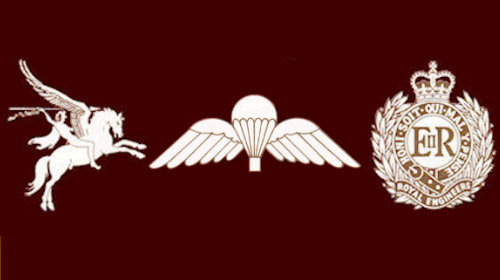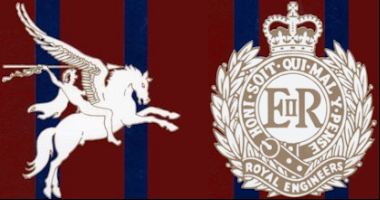
The Sqn in Germany 1975
9 Indep Para Sqn in Germany 1975
 |
Above: An American made infantry bridge in service with the Germans is tested out by the British |
UBIQUE, the Latin motto shared by the Royal Engineers and the Royal Artillery, was chalked on the German soldiers’ briefing blackboard. “I was just explaining between ubique for us and ubique for the gunners” said a British Sapper. He added impishly, “for us it means everywhere, for them it means all over the ruddy place.”
Regimental rivalries apart, the Bundeswehr hosts of 9 Independent Parachute Squadron, Royal Engineers, during nearly a month of joint exercising, were left in no doubt that the versatility of Sapper skills displayed by the unit earned the motto “everywhere.” The whole object of the exercise was to extend that versatility by getting by getting to know German soldiers as NATO allies and comparing notes as fellow Sappers facing the same engineering problems with often vastly different equipment.
The bulk of the Squadron arrived by road in Munich after a punishing drive all the way from Antwerp. But the Sappers were soon refreshed by the warm welcome of their hosts, 290 Panzer Pionier Kompanie at the Pionierschule-Engineer School. The British were shown the latest Bundeswehr engineering plant plus the minelaying and demolition techniques of the German combat engineer.
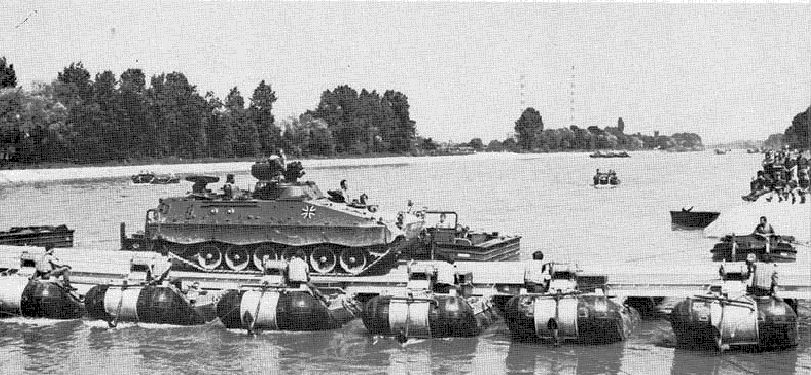 |
A Bundeswehr Marder AFV uses a German inflatable bridge while men of 9 Squadron and their hosts look on |
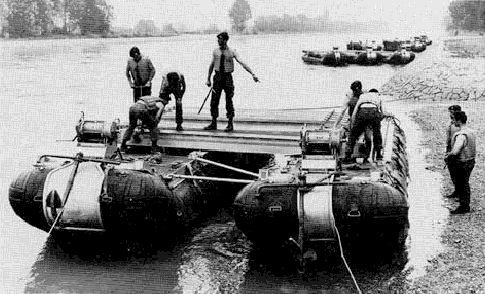 |
The British troops master German bridge building |
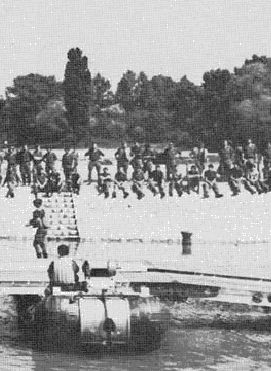 |
A day on the ranges gave the British a chance to handle the Germans’ infantry weapons including their rifle, Spandau machine gun, the little Uzi sub machine gun and the compact Walther automatic pistol. Meanwhile one troop joined other elements of 16th Parachute Brigade on exercise in Italy with troops from that country and the United States.
Back in Bavaria, the Squadron moved from Munich to nearby Ingolstadt, home of the German engineers’ bridging camp which is attended by every Sapper in the German Army at one time or another. The attraction for Sapper bridgelayers here is the challenge of the fast flowing Danube, well over 100 metres wide at this point, which was swollen during 9 Squadron’s visit to a muddy grey/green instead of its legendary blue. The current slid quickly by at some 2.3 metres per seconds the Germans prepared to show the British their MLC 60 bridge comprising of aluminium decking sections mounted on vast inflatable pontoons.
The experts of 4th Pionier Battalion, who had taken over as the Squadron’s German hosts, explained that one of the main advantages of the MLC 60 is that it can be manhandled off its transport to the riverbank without calling on heavy plant for assistance. A seven nozzle two stroke powered compressor inflates and deflates the black rubber pontoons, which contain 14 independent buoyancy chambers, six each side and two in the middle. The multiple compartments are designed to stop the pontoons sinking if shot at.
Once both ramped ends of the bridge have been aligned and secured opposite each other, sections of three decked pontoons drop sturdy anchors upstream of the bridge site and edge down on the anchor cable, paid out by winch, to take up their positions in the floating span. The men of 9 Squadron soon got the hang of the unfamiliar kit and after manning the bridge on a half-and-half crew basis with the Germans they practised erecting and dismantling it on their own.
Next it was the turn of the visitors to show their hosts the British class 16 airportable bridge. Major Mike Payne, explained that most bridges fulfil only one of the three river crossing requirements but the class 16 could be used for all three, rafting, floating bridges and fixed span dry bridging.
Four main items make up the class 16, metal deck boxes which form the main trackway, articulating pieces to join the boxes, ramps for each end of the bridge and rafting sponsons with 40 horsepower outboard motors to manoeuvre the raft in the water. Inflatable floats can be attached to the bridge sides and are blown up direct from the towing vehicles’ exhausts. The flood water on the Danube was too fast to really put the bridge through its paces but both German and British engineers built and manoeuvred the class 16 in a small backwater harbour.
German observers remarked on the individual initiative the British soldiers were allowed and used to advantage while they worked on their bridge with little direction from their troop commander or senior non-commissioned officers.
It was back to German equipment for another exercise, this time with an American infantry footbridge made up of small, open topped pontoons supporting a single track deck to carry a file of men who could steady their crossing with a rope handrail. Each pontoon was attached to a wire slung across the river and a span of 144 metres was pushed out over the fast flowing Danube in just over a quarter of an hour by men of 9 Squadron.
“”Bridging is no different the world over” commented Major Payne. “The basic problems are the same but by using other people’s equipment you realise more about your own by comparing the two.”
For the final phase of the joint exercising 9 Squadron moved to the elaborately equipped German parachuting school at Schongau, near the Austrian border. Determined to win their German parachute wings, which they are allowed to wear on their parachute smocks. The Sappers had to get used to yet more different kit to do the five jump course. Unfamiliar American harness, including one and a half shot capewell releases which can be used to cut away a malfunctioned main canopy, needed careful buckle adjustment to ensure a snug fit.
The main difference the British parachutists found hardest to adjust to was the jump height of 1500 feet, more than double they are used to at home. Jumping from C160 aircraft, a smaller version of the C130 Hercules, the main concern was the canopies might get entangled after mid-air collisions on the relatively long drop of 1500 feet. But few problems arose and the jump course ensured a record number of parachute descents as a unit in 12 months, a record unequalled for 15 years.
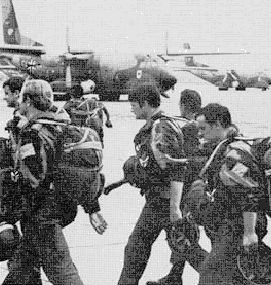 |
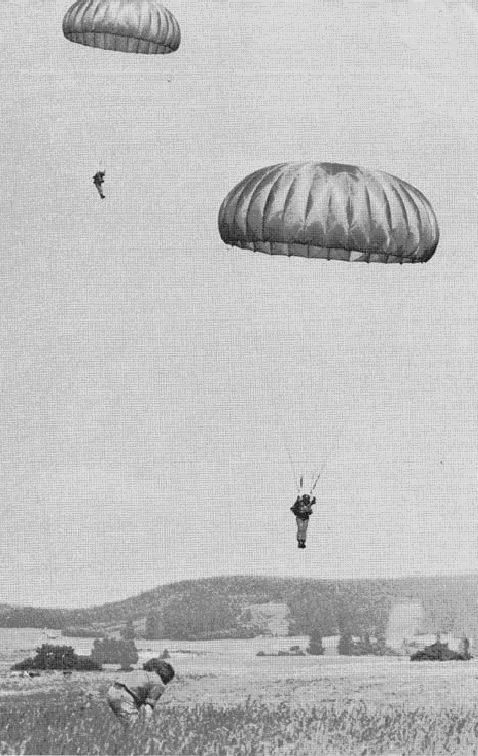 |
The Para Sappers join German Airborne soldiers to jump unfamiliar T10 chutes from the C130’s smaller sister |
|
During much of the training period a handful of the Squadron’s qualified divers, led by Sergeant Peter Kershaw, were guests of the German Army’s diving school at Percha on the banks of the Starnbergersee, a renowned holiday resort in south Bavaria.
 |
These diving platforms on spectacular Starnbergersee were used for training |
The Squadron’s divers were most impressed with the Germans “hard hat” diving suits. The globe-like helmet, thick suiting and cast iron over-shoes make a man grotesquely ungainly on land but allow a surprising freedom of movement under water.
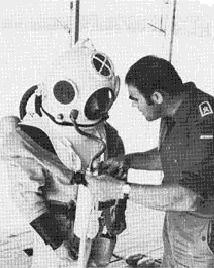 |
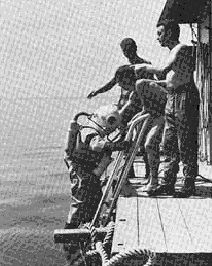 |
A German expert explains the “hard hat” suit to one of 9 Squadron’s own divers |
Going down…The British divers were full of praise for the German equipment |
“Standard” diving suits of this kind are used more by German divers than the Sapper divers trained at the Marchwood diving school and the Squadron’s own divers took the opportunity to practice welding, joinery and other feats of dexterity under water, using their hosts equipment. Meanwhile they loaned to the Germans the wet suit diving sets they had brought from England.
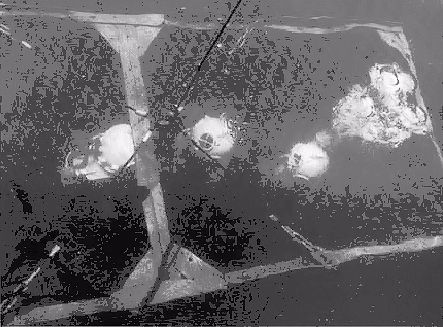 |
The clear waters of Starnbergersee are ideal for underwater training tasks |
The divers mixed socially as well as at work and compared notes on their two armies. Cpl Tony Atkinson, a well borer by trade who is also one of the Squadron’s divers, summed up, “The Germans are surprised how versatile we are. They tend to be one man-one job and they are amazed how much we travel. In eight years I’ve been all over the world to literally every continent. They just move around Germany. We’re infantry, parachutists, drivers, divers, combat engineers, mine and demolition experts. The Germans find it difficult to understand this.”
Indeed 9 Squadron’s visit has proved to their hosts that “ubique” really does mean “everywhere” for the Royal Engineers.
